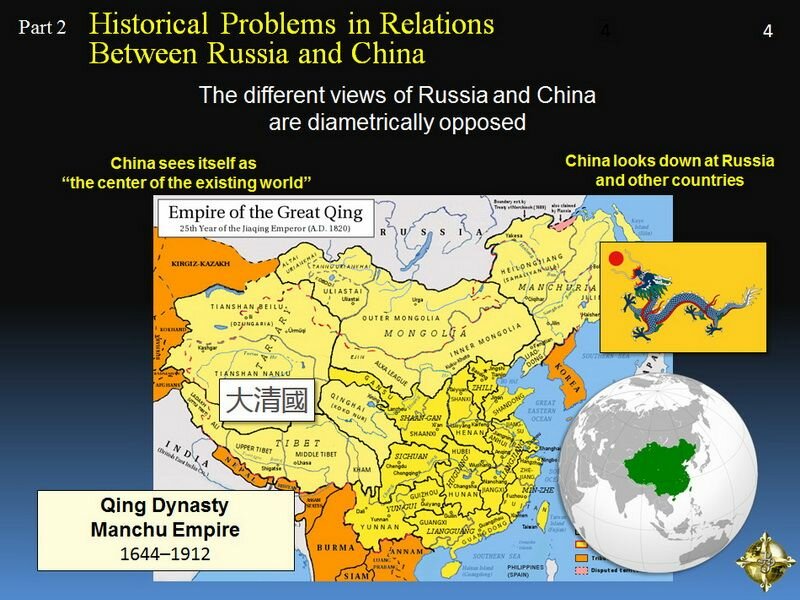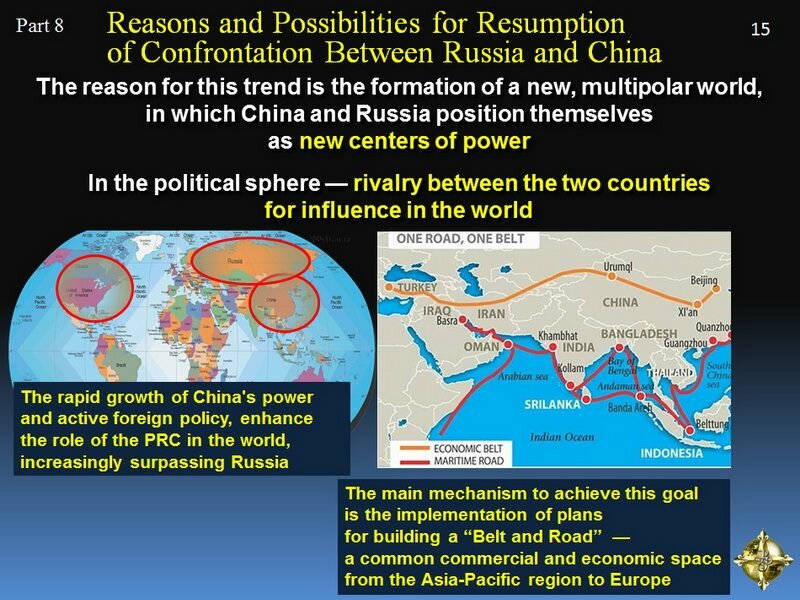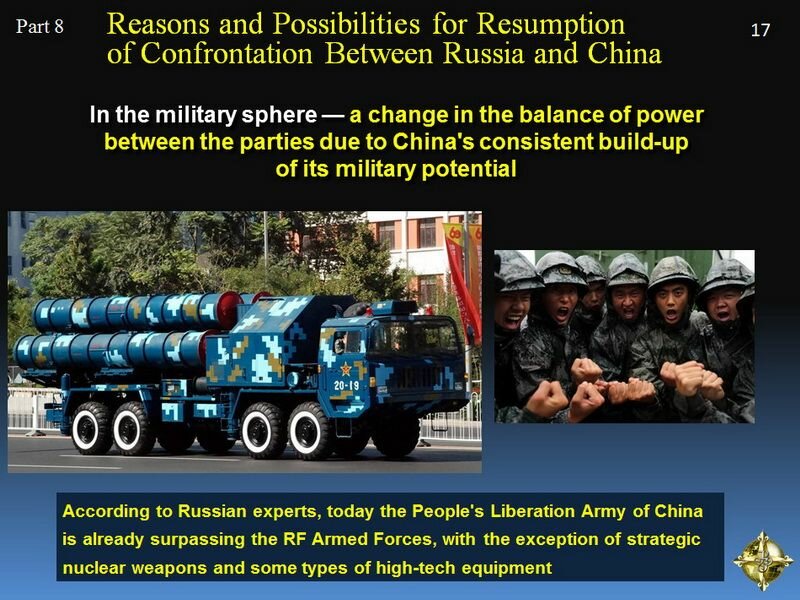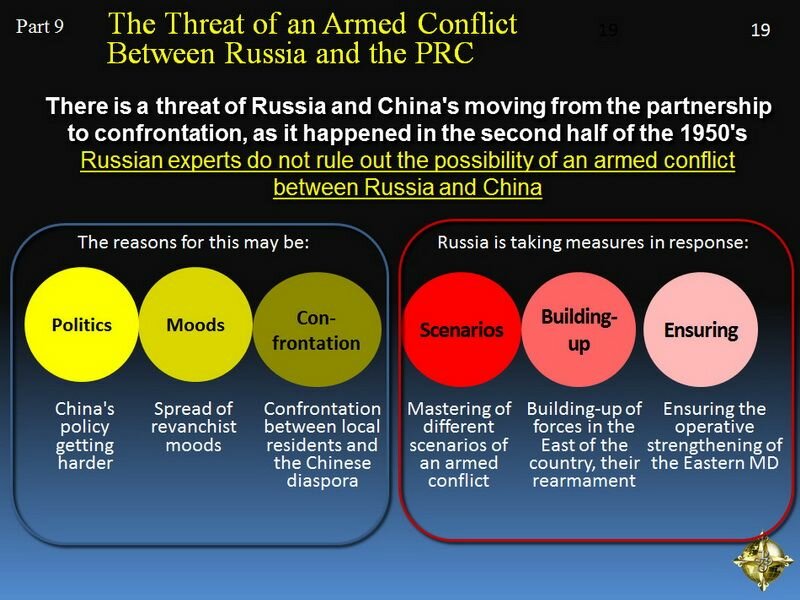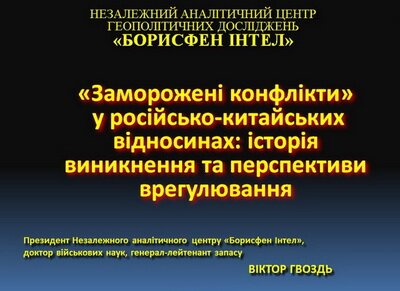
May 24, 2019, at the Diplomatic Academy of Ukraine there was an International Conference themed “The RF's Conflict Potential: the State and Prospects of Development”. The event was organized by the Center for Russian Studies (Ukraine) and the Kobe Gakuin University (Japan).
At the conference, President of the “Borysfen Intel” Independent Analytical Center for Geopolitical Studies Victor Hvozd spoke on “Frozen Conflicts” in Russian-Chinese Relations: the History and Prospects for Settlement”.
*************************************
Dear colleagues! During our previous meetings, we repeatedly touched upon the theme of Russian-Chinese relations. However, this issue is extremely broad and multifaceted and remains relevant. Especially as it has a growing influence on both, the world situation and Ukraine’s interests. In view of this, it is worth returning to it again.

|

|

|
1. Are Russia and China Strategic Partners or Rivals and Opponents?
According to official declarations of the leaders of the two countries, the parties are building a strategic partnership for a long-term perspective. This is confirmed by systematic contacts between Russia and the PRC (at the highest and other levels), demonstrations of common ground in the international arena, deepening of trade and economic cooperation between the two countries, and their interaction in the security sphere.
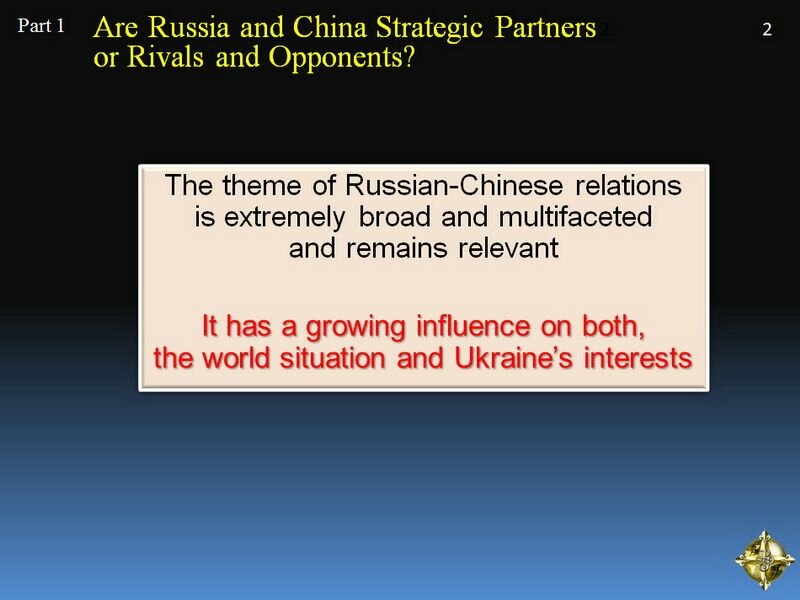
|
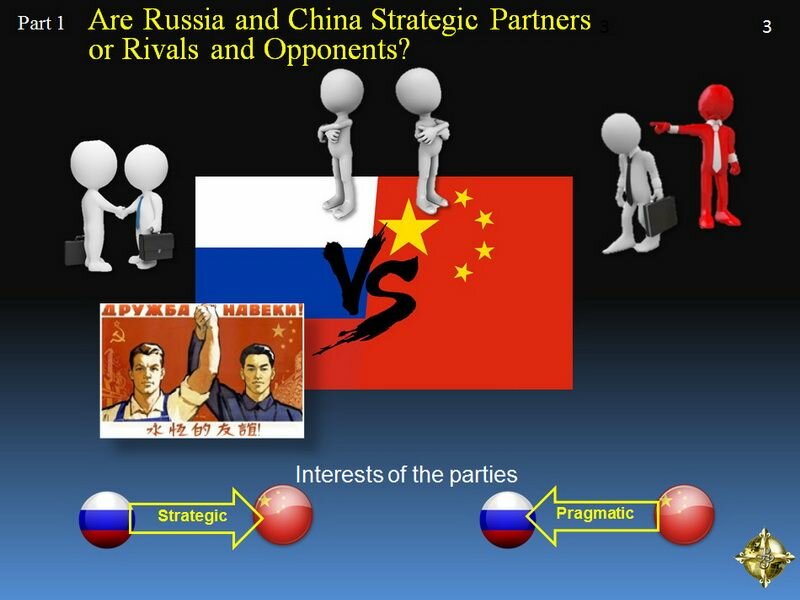
|
At the same time, a thorough analysis of the nature and characteristics of relations between Russia and the PRC allows to draw a conclusion about the purely situational nature of such a partnership, which is mainly related to the current interests of the parties. At this, while to Russia they really are strategically important, to China they are mostly pragmatic.
Moreover, in relations between Russia and the PRC, there are problems that have a historical background and those associated with the current geopolitical situation in the world.
2. Historical Problems in Relations Between Russia and China
Historical problems in relations between Russia and China are well known, widely covered in the media and studied in various scientific works. Despite this, the problems continue to exert influence on Russian-Chinese relations.
The main source of such problems is the different views of Russia and China, which are diametrically opposed.
Thus, China, which has more than three thousand years of history, has survived all other ancient empires, Egypt and Rome included, and quite clearly sees itself as “the center of the existing world”. That is what forms the basis of the Chinese world view and most philosophical trends of the country. According to this approach, China looks down at Russia and other countries both, in the historical context, and at present and in the future.
A completely different position is taken by Russia, which pursues an active expansionist policy from the very beginning of the establishment of the Moscow kingdom in the 15th century. Within the framework of this policy, in the 17th century Russia was confronted with China, which at that time was ruled by the Qing (Manchu) Dynasty. In the middle of the 19th century, China was in an extremely difficult situation, used by Russia for its expansion in the Far East.
As a result, in relations between Russia and the PRC there had been formed three sets of problems that actually exist to this day.
-
 at the strategic level — the main problem is the rivalry between the two countries in the international arena in various forms and spheres. As noted above, clashes between the countries' worldviews are the basis of such rivalry.
at the strategic level — the main problem is the rivalry between the two countries in the international arena in various forms and spheres. As noted above, clashes between the countries' worldviews are the basis of such rivalry.
However, until the middle of the 20th century, it had been hidden due to superiority of the Russian Empire, and then the USSR over China, as well as Beijing's being interested in the positive development of bilateral relations.
Since the beginning of China's getting stronger from the middle of the 20th century, this situation has changed fundamentally. Thus, in the second half of the 1950s, China moved to an open confrontation with the Soviet Union based on ideological differences between the two countries and Beijing's desire to take a dominant position in the socialist camp. And since 2010, after the PRC's having turned into a leading world power, rivalry between China and Russia has reached the world level.
In more detail, all these issues will be analysed later.
- at the regional level — the problems in relations between the parties are the PRC's negative attitude to Russia's (later — the USSR's) policy towards Mongolia and Xinjiang, as well as disagreements over the influence in the Asia-Pacific and South-East Asia.
 From the beginning of the collision of Russia's and China's interests in the 17th century, the Russian side considered Mongolia and Xinjiang as “buffer zones” between the two countries. In view of this, Russia, and then the USSR, provided assistance to insurgents, both in Mongolia and in Xinjiang. Within the framework of such a policy, in 1945, the USSR made China recognize Mongolia's independence. However, this was not done in relation to Xinjiang.
From the beginning of the collision of Russia's and China's interests in the 17th century, the Russian side considered Mongolia and Xinjiang as “buffer zones” between the two countries. In view of this, Russia, and then the USSR, provided assistance to insurgents, both in Mongolia and in Xinjiang. Within the framework of such a policy, in 1945, the USSR made China recognize Mongolia's independence. However, this was not done in relation to Xinjiang.
In turn, China considers Mongolia and Xinjiang its historic territories. In view of this, Russia's support for national liberation movements among the population of these regions in the past and now has been seen by Beijing as manifestations of Moscow's colonial policy. Among other things, aimed at undermining China's territorial integrity.
Mongolia. Based on politico-geographical realities, Russia, and later the USSR, assisted national liberation movements in the neighboring regions of the Northern (or, as China calls it, Outer) Mongolia. In 1945, under the Yalta agreements between the USSR and its partners in the anti-Hitler coalition (in particular, the return to the Soviet Union of its sphere of influence in the Far East), Moscow forced Beijing to recognize independence of Northern Mongolia.
Xinjiang. The Russian Empire had considered Xinjiang as a so-called Eastern Turkestan, historically connected with Western Turkestan, namely, Moscow-controlled territories of Central Asia. In view of this, the Russian Empire and the USSR assisted the Xinjiang rebels, various Islamist movements included.
At the same time, neither the Russian Empire nor the USSR were going to create an independent Xinjiang state, since there was virtually no powerful state-building force there. As a result, the attempt to create an independent Xinjiang could only lead to the emergence of a permanent centre of conflict near the Russian, and later — Soviet border.
Along with this, a certain historical problem in relations between China and Russia remains the parties' different attitudes to the Korean War of 1950–1953. According to the views of the Chinese side, the USSR avoided direct participation in the war and tried to get material, territorial and political benefits from it.
Vietnam is a similar problem. The reason was Vietnam's siding with the USSR during the period of sharpening contradictions between the Soviet Union and China in the 1970s. This problem was particularly acute during the China-Vietnam War of 1979, following Vietnam's invasion of Cambodia, which was supported by China.
To date, the problems mentioned are in the past, but they still remain in the historical memory of Russia and China.
- at the local (border) level — a potential problem is China's territorial claims to Russia, despite the resolution of the most acute border issues.
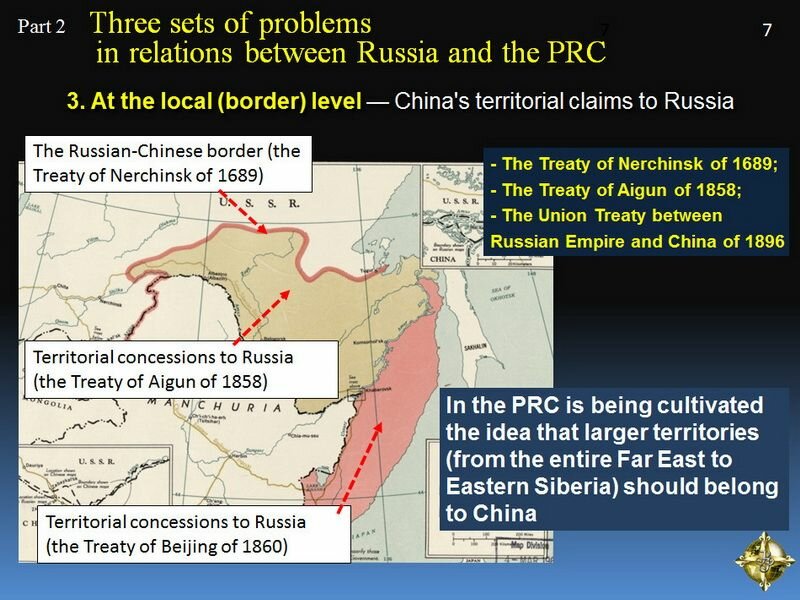 The origins of such claims are because of the inequality of treaties between the Russian Empire and the Qing (Manchu) Dynasty. Most of them were imposed by Russia on the Qing Dynasty because of its difficult situation since the second half of the 19th century. As a result, Russia gained a significant part of Manchuria, including Primorye (Ussuri Territory).
The origins of such claims are because of the inequality of treaties between the Russian Empire and the Qing (Manchu) Dynasty. Most of them were imposed by Russia on the Qing Dynasty because of its difficult situation since the second half of the 19th century. As a result, Russia gained a significant part of Manchuria, including Primorye (Ussuri Territory).
For the first time, the adjacent territories of present-day Russia and China were officially divided in 1689 under the so-called Treaty of Nerchinsk. The treaty was concluded between the then Russian Tsardom and the Manchu (Qing) Empire, which captured China. At this, due to the Manchu Empire's military superiority in the Far East, Russia was forced to give it a part of its lands in the region. In particular, the border passed along the Argun River and further along the Stanovy ridge to the coast of the Sea of Okhotsk.
In the middle of the 19th century, after the weakening of the Qing Dynasty as a result of opium wars, Russia imposed on it a new territorial division. Under the Treaty of Aigun, which was signed in 1858, Russia got a significant part of Manchuria, including the Primorye (Ussuri Territory).
The subsequent decline of the Qing Dynasty (due to internal uprisings in China and Japan's intervention in 1884–1885, let Russia take further steps to strengthen its positions in the Far East.
Thus, in 1896, Russian Empire and China signed the Union Treaty, according to which Russia got the right to build Chinese Eastern Railway in Manchuria. And in 1887, in exchange for the economic aid to the Qing Dynasty, Russia received the lease of Port Arthur and Dalian. At the same time, these ports and part of the Chinese Eastern Railway were lost by Russia after its defeat in the war with Japan in 1905.
Such a division of territories remained virtually unchanged after the fall of the Qing Dynasty in 1912 and creation of the Republic of China, later — the People's Republic of China. In turn, this created prerequisites for China's territorial claims to Russia, and then to the Soviet Union.
At the official level, such claims mainly concerned individual border areas and were resolved after the collapse of the USSR.
At the same time, in the PRC is being cultivated the idea that larger territories (from the entire Far East to Eastern Siberia) should belong to China.
These problems in the relations of the parties would for some period of time sharpen under the influence of various factors. In particular, in the modern history, such a period lasted from the second half of the 1950s to the mid-1980s.
3. Complication of Relations Between the USSR and China in Late 1950s – Mid 1980's
The reasons for the sharpening of relations between the USSR and China in the mentioned period are also well known. At the same time, they and their consequences need attention as a precedent for the possibility of a rapid turning of friendly and mutually beneficial relations between the two countries into a fierce confrontation.
Thus, from the end of the 1930s to the mid-1950s, the common interests of the USSR and China to counter the expansion of Japan, and then of the United States, created the basis for the active development of the Soviet-Chinese cooperation in the political, economic, military and other spheres. It was supplemented by the common communist ideology of the parties and similar vision of its basic principles and ways of their realization. Within the framework of the strengthening of friendly relations between the two countries, the USSR made a number of territorial concessions to China.
In 1937–1942, Soviet military advisers and specialists assisted China in the war against the Japanese invaders. In the same period, with the help of the USSR, 3,000 kilometres of motorway was built in Xinjiang, and the development of oil fields began. And in 1939, China and the USSR concluded a trade agreement.
In 1945, the Soviet Union defeated the Japanese Kwantung Army in the territory of Manchuria. In 1945–1949, with the support of the USSR, Mao Zedong and the Communist Party of China came to power in country. In October 1949, the USSR became the first country in the world to recognize the People's Republic of China.
In 1949–1956, Soviet-Chinese relations became particularly close. Thus, the Soviet-Chinese Treaty on Friendship, Union and Mutual Assistance was signed. The USSR assisted China in restoring and developing its economy and building the armed forces. China was supplied with both, conventional weapons, and technology for creation of nuclear weapons.
In addition, in 1950 the USSR handed over to China Dalian, in 1952 — Chinese Eastern Railway, and in 1954–1955 — Port Arthur.
From the second half of the 1950s, this situation became fundamentally different, which was the result of ideological contradictions between the two countries. At this, they were used by the leader of the PRC at that time Mao Zedong to strengthen his positions in the country and throughout the socialist camp.
The reason for such changes was the condemnation by the leadership of the USSR of the cult of J. Stalin's personality and moving to the policy of peaceful coexistence with capitalist countries, which caused sharp criticism from Mao Zedong. For example, he accused the Soviet leadership of revisionism, betrayal of Marxism-Leninism and capitulation to the West.
Mao Zedong also stepped up the issue of the inequality of treaties concluded between the Russian Empire and the Qing Dynasty (with the exception of the Treaty of Nerchinsk). On these grounds, he put forward territorial claims to the USSR, and demands to satisfy them.
All these issues were used by Mao Zedong to fight his rivals in the leadership of the PRC, and to justify the so-called Cultural Revolution as the country's new domestic policy. In particular, on charges of love to the USSR and countering the Cultural Revolution, a number of Mao Zedong's opponents in the leadership of the Communist Party of China were repressed.
All this resulted in the sharp confrontation between the USSR and China in the political and ideological spheres, actual break of relations and termination of trade and economic cooperation between the two countries, as well as a number of border conflicts. The largest of these was the conflict around the Island of Damansky on the Ussuri River in March 1969.
The PRC's actions were strongly condemned by the leadership of the USSR, which accused Beijing of imperialist policy under the mask of assisting the countries of Asia, Africa and other regions in their struggle against colonialism.
At the same time, as part of demonstration of its dissatisfaction with the Maoist policy, the USSR withdrew the entire corps of Soviet specialists who had been working in the PRC under the program of international cooperation.
Besides, the Soviet Union minimized the trade with the PRC, and actually suspended all other contacts.
In turn, China began active measures of pressure on the USSR, including by demonstrating the force on the Chinese-Soviet border and attempting to forcefully resolve territorial disputes.
This resulted in a number of border conflicts between China and the USSR. Apart from the conflict around the Island of Damansky, in May 1969, China conducted another armed provocation in the village of Dulati (Almaty region of Kazakhstan). And in August 1969, another border conflict took place in the area of Lake Zhalanashkol in the east of Kazakhstan.
The diplomatic efforts of the USSR and the PRC helped prevent turning of border conflicts into a full-scale war between the two countries. However, this in no way meant a real improvement of their relationship.
Moreover, political-ideological disagreements between the parties reached a qualitatively new strategic level.
In 1974, China put forward the theory of “three worlds”. According to it, the world was divided into three parts, namely: super powers — the USSR and the USA; “the second world” — developed countries; and “the third world” — developing countries. At this, the USA and the USSR were declared China's main adversaries.
China also stepped up its efforts to gain leadership in the socialist camp and among the communist movements in the world, which ended in their split. Thus, communist parties of some countries, including Albania, North Korea and Indonesia, sided with the PRC.
Besides, China began an active development of relations with the USSR's adversaries — the United States and Japan. In particular, as part of the policy, Beijing condemned invasion of Soviet troops to Afghanistan in 1979, and also supported Western sanctions against the Soviet Union.
Such actions of China weakened the USSR's positions in the world and made it spend significant resources to confront the PRC. For example, in the 1970s, the most powerful groups of troops of the Soviet Army was deployed specifically against China, which was considered a greater threat to the USSR than NATO.
4. The Beginning of Normalization of Relations Between China and the USSR
Since the early 1980s, relations between the USSR and the PRC had begun to normalize. At the first stage, the reason for such changes was the commonality of the parties' anti-American interests. And in the future — of their economic interests.
After a certain period of improvement in Sino-US relations, in the early 1980s they got a further escalation. The reason for this was the USA's active countering China's policy of regaining control over Taiwan. Besides, the United States' building up its nuclear potential was perceived by China as a threat to its own security.
China's abandoning Maoist policy was also important, as it had been creating ideological obstacles to the development of Chinese-Soviet relations. In 1981, at the Plenum of the CPC Central Committee, China's new leader, Deng Xiaoping, criticized Mao Zedong's main ideas as “leftist mistakes” and launched a more liberal policy of the country.
Given these changes and their own interests, Moscow met Beijing half way. In March 1982, the USSR unveiled new principles of relations with the PRC, which included: recognition of the existence of the socialist system in China, which makes it similar to the Soviet Union; assistance in resolving the Taiwan issue in favor of China; the USSR's giving up any territorial claims to China and readiness for negotiations on resolving border issues; Moscow's readiness to start a dialogue with Beijing on improving Soviet-Chinese relations based on the principles of mutual interests and non-interference.
All this marked the beginning of a restart of cooperation between the USSR and the PRC. By the end of the 1980s, relations between the two countries were actually fully restored.
In 1984–1985, a number of Soviet-Chinese agreements were signed on economic, technical and scientific cooperation, as well as the construction of industrial facilities in the PRC.
Later, of decisive importance in normalizing the relations between the parties was M. Gorbachev's proclamation of the policy of the USSR's openness to the world. Proceeding from there, on May 18, 1989, a joint Soviet-Chinese communiqué was adopted in Beijing, which laid the political basis for the long-term relations between the two countries.
5. The Rapprochement Between Russia and China After the Collapse of the USSR
After the collapse of the Soviet Union in 1991, relations between the new Russia and China came to a qualitatively new level. First of all, due to the parties' final giving up the ideological component in their relations, and the two countries' being interested in deepening economic cooperation.
 Within the framework of reforms under the leadership of Deng Xiaoping, by the early 1990's, China's leadership had finally got rid of the legacy of Maoism and created a new political and economic system in a country that combined elements of socialism and market capitalism. Simultaneously, China's policy aimed at modernizing and speeding up the development of the Chinese economy, and strengthening the military potential of the country. In turn, this required expansion of China's access to modern civilian and military technologies, and to foreign markets.
Within the framework of reforms under the leadership of Deng Xiaoping, by the early 1990's, China's leadership had finally got rid of the legacy of Maoism and created a new political and economic system in a country that combined elements of socialism and market capitalism. Simultaneously, China's policy aimed at modernizing and speeding up the development of the Chinese economy, and strengthening the military potential of the country. In turn, this required expansion of China's access to modern civilian and military technologies, and to foreign markets.
However, because of China's totalitarian nature, the United States and leading European countries in fact refused to let it to their technologies and markets. In particular, the events on the Tiananmen Square in 1989 (the suppression of student demonstrations by the armed forces of the People's Republic of China) led to significant human losses. In view of this, the United States and European countries imposed sanctions against China.
Unlike this, the USSR, and then Russia, continued political and trade-economic cooperation with China, including the supply of arms and the transfer of modern military technology. Moreover, as a consequence of the socio-economic crisis in Russia after the collapse of the Soviet Union, such cooperation has been greatly expanded.
In 1992–2005, a number of agreements and treaties were concluded between the two countries that laid foundations for their relations in the economic and political spheres. The main ones were the Intergovernmental Agreement on Trade and Economic Cooperation between Russia and China (March 1992) and the Treaty of Good-Neighborliness and Friendly Cooperation between the Russian Federation and the PRC (July 2001).
Since 2005–2007, Russia and China have also intensified their cooperation in the military sphere as a result of the coincidence of their interests in the common opposition to the USA, international terrorism and “color” revolutions. In this regard, their military-technical cooperation included joint military exercises, systematic consultations on regional and world security, and other measures. As a rule, such measures demonstrate the parties' common negative attitude to the USA's actions in the military-political sphere, including the intensification of military exercises in the Asia-Pacific region, deployment of missile defense systems, etc.
 In 1992, they created the Russian-Chinese Mixed Intergovernmental Commission on Military-Technical Cooperation, which defines the main directions of interaction between the parties in this sphere and the ways of implementation of joint projects.
In 1992, they created the Russian-Chinese Mixed Intergovernmental Commission on Military-Technical Cooperation, which defines the main directions of interaction between the parties in this sphere and the ways of implementation of joint projects.
Within the framework of the military-technical cooperation between the two countries, Russia has provided the PRC with a significant amount of arms and military equipment, including about 300 heavy Su-37/30 fighters, military transport aircrafts Il-76 and aerial refueling tankers Il-78, about 20 diesel submarines, several surface ships and anti-ship missiles “Moskit”, M-80E cruise missiles, T-80U tanks, “Tor-M” anti-aircraft missile systems “Buk”, S-300 PMU1 and S-400, guided air bombs and artillery ammunition. At the same time, China began its own production of a number of weapons under Russian licenses.
In November 1993, the Agreement on Military Cooperation between the Defense Ministries of Russia and the PRC was signed. From that moment on, direct links have been established between the armed forces of the two countries. The next step was the signing in July 2001 Treaty of Good-Neighborliness and Friendly Cooperation between the Russian Federation and the PRC, which made it possible to bring the two countries' interaction in the military sphere to the strategic and systemic level.
In particular, a direct phone line was established between the two Defense Ministries, there began systematic meetings of the high military command’ representatives, exchanges of military delegations and visits of warships, was restored the practice of training Chinese military personnel in military schools of Russia and they began to conduct joint military exercises.
For example, since 2005, there has been conducted joint Russian-Chinese exercise “Peace Mission”. The parties master interaction in fighting terrorism, extremism and separatism.
Later, the “Naval Interaction” joint exercise was launched. The tasks of joint maneuvering, organization of communication, missile-artillery firing, as well as search-and-rescue operations are performed. The feature of the exercises is their being conducted in two regions, namely, in the Far East and in the Baltic Sea.
Besides, Russian military units take part in exercises of the Armed Forces of the PRC, and Chinese units — in exercises of the RF Armed Forces.
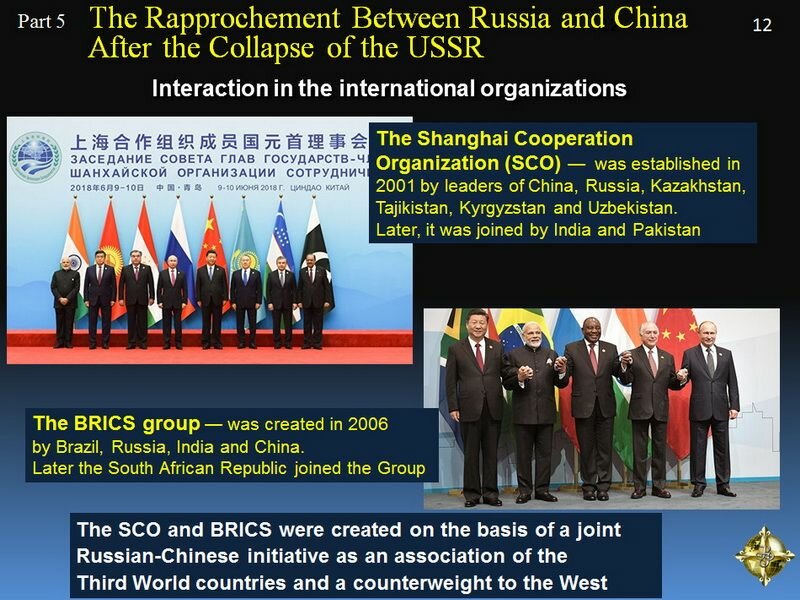 A separate sphere of cooperation between Russia and China is their interaction in the international organizations. Among them, a special place is occupied by the SCO and BRICS, which were created on the basis of a joint Russian-Chinese initiative as an association of the Third World countries and a counterweight to the West.
A separate sphere of cooperation between Russia and China is their interaction in the international organizations. Among them, a special place is occupied by the SCO and BRICS, which were created on the basis of a joint Russian-Chinese initiative as an association of the Third World countries and a counterweight to the West.
The Shanghai Cooperation Organization (SCO) was established in 2001 by leaders of China, Russia, Kazakhstan, Tajikistan, Kyrgyzstan and Uzbekistan. Later, it was joined by India and Pakistan. The total territory of the countries that are part of the SCO is 34 million square kilometres — 60 % of the territory of Eurasia; the total population — 3 billion 40 million people. According to the official charter of the SCO, the main tasks of the Organization are to strengthen the stability and security of the members of the Organization, to fight terrorism, separatism, extremism and drug trafficking, to develop economic cooperation, energy partnership, scientific and cultural cooperation.
The BRICS group was created in 2006 during the St. Petersburg Economic Forum with the participation of the Ministers of Economy of Brazil, Russia, India and China. Later the South African Republic joined the Group. The main objectives of the BRICS group are to coordinate the actions of the parties in order to promote their economic development. However, the Group is a rather amorphous structure — in fact, a special political and economic interest club.
6. The Russian-Chinese Relations' Reaching a Qualitatively New Level After the Resumption of the Confrontation Between Russia and the West
Since 2014, relations between Russia and China have become especially close. Thus, by deepening cooperation with China, Moscow tries to compensate for Western sanctions against Russia, and to strengthen its international positions. In particular, Moscow has declared “turning” its energy flows from Europe to China.
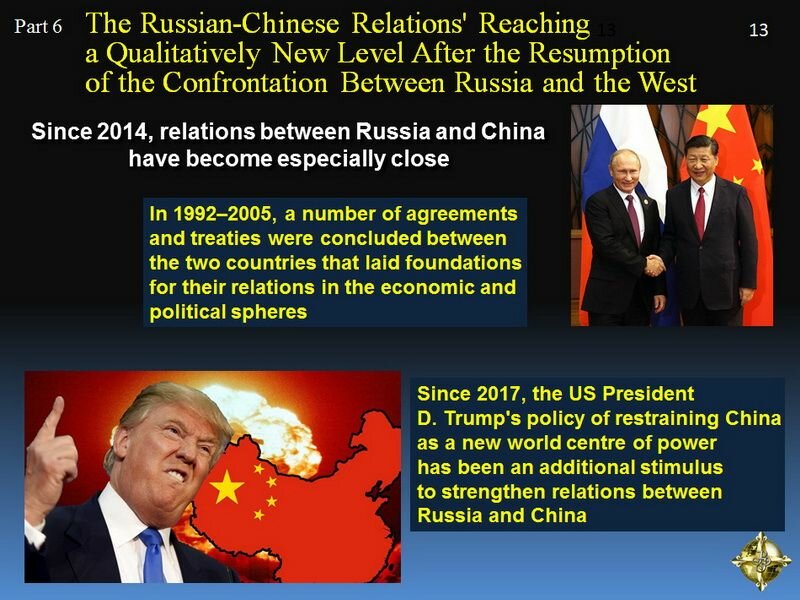 In turn, Beijing uses the situation to its own advantage — to expand access to Russian natural resources, markets, transport infrastructure and the most lucrative sectors of the economy.
In turn, Beijing uses the situation to its own advantage — to expand access to Russian natural resources, markets, transport infrastructure and the most lucrative sectors of the economy.
On the basis of such interests, in recent years the parties have concluded a new package of agreements in the trade-economic, energy and infrastructure spheres.
Major of them are: the “Shanghai” and “Moscow” agreements of 2014; “Moscow” agreements of 2015; “St. Petersburg” agreements of 2016.
Among them, the most important deal was the agreement between Russian Gazprom and the China National Petroleum Corporation (CNPC) on deliveries of Russian gas to China in the amount of 38 billion cubic meters annually. The deal is for 30 years, and its total cost is estimated at 400 billion US dollars.
All this allowed to ensure a positive dynamics of trade growth between Russia and China, which in 2018 reached the level of more than 100 billion US dollars.
Since 2017, the US President D. Trump's policy of restraining China as a new world centre of power has been an additional stimulus to strengthen relations between Russia and China. In turn, this has created a more powerful foundation for deepening the interaction between Moscow and Beijing on an anti-American basis.
At this, the parties' political, trade and economic cooperation was complemented by military cooperation between them. In particular, most indicative was the participation of the brigade tactical group of the People's Liberation Army of China in the strategic command-post exercises of the Russian Armed Forces “East-2018” in August–September 2018.
In total, 3,200 Chinese military personal with arms and military equipment (all in all, around 900 pieces) participated in the SCPE, and an aviation group consisting of 6 aircrafts and 24 helicopters.
7. The Policy of Russian Concessions to China
Since 1991, the development of Russian-Chinese relations has been accompanied by Russia's actions in favor of China in a number of important spheres. The reasons for this are as follows:
- Russia's losing the ability to really resist China due to a significant narrowing of the former's economic and military potential after the collapse of the USSR;
- Moscow's desire to provide most favorable conditions for deepening cooperation with the PRC by resolving disagreements.
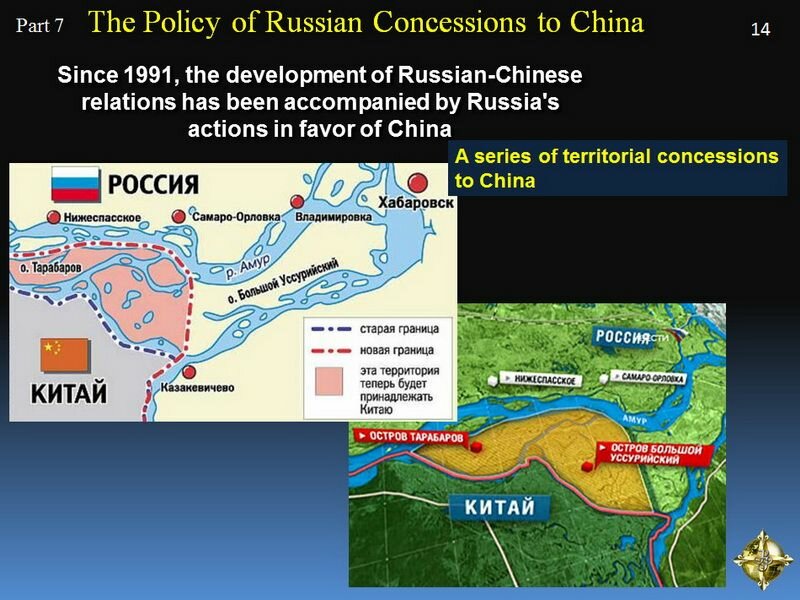 An example of such Moscow's policy was a series of its territorial concessions to China, which were made in 1992–2008. All in all, during that period, Russia gave away to the PRC 337 square kilometres of island and land areas.
An example of such Moscow's policy was a series of its territorial concessions to China, which were made in 1992–2008. All in all, during that period, Russia gave away to the PRC 337 square kilometres of island and land areas.
In particular, the islands Damansky (subject of the armed conflict of 1969) and Tarabarov, and a part of the Island of Great Ussuri on the Amur River were transferred to China.
The grounds for this were: the Agreement between the USSR and China on the Soviet-Chinese state border in its Eastern part from May 15, 1991; the 1994 Agreement between Russia and the PRC on the Russian-Chinese border in its Western part; the Additional Agreement between Russia and the PRC on the Russian-Chinese border in its Eastern part from October 15, 2004.
Since 2014, Russia's policy of concessions to China has reached a qualitatively new level. For example, Russia has in fact opened the door for Chinese expansion in Russian territories. Manifestations of such actions of Moscow were:
- providing China with the possibility of actually establishing control over Russian territories in the form of their long-term lease;
- opening of ways for the massive resettlement of Chinese citizens into neighboring with China regions of Russia's Eastern Siberia and Far East;
- maximum expansion of China's access to Russian natural resources, economy and markets, which is gaining uncontrolled character.
Such opportunities are being opened by the law “On the Territories of Advanced Socio-Economic Development” which was adopted in December 2014 against the background of the introduction of the USA and EU's sanctions against Russia. The law provides for the possibility of land lease to foreigners for up to 50 years, where privileged economic activities can be carried out, including virtually unlimited involvement of foreign labor.
Despite the fact that the law does not give advantages to any foreign country, it was actually adopted in favor of China. Thus, since 2015, such zones have been mainly created in Russia's Eastern Siberia and Far East. In particular, among them there are: “Khabarovsk” and “Komsomolsk” in the Khabarovsk Territory; “Nadezhdinskaya”, “Kamchatka” and “Mikhailovskaya” in Primorye; “Priamurskaya” and “Belogorsk” in Amur region.
All in all, within these and other projects, about 4 million hectares of Russian territories have been leased and are planned to be leased to China.
On the whole, the above-mentioned circumstances make an impression of a strategic partnership between Russia and China. At the same time, disagreements between them do not just remain unresolved, but have reached a qualitatively new conflict potential.
8. Reasons and Possibilities for Resumption of Confrontation Between Russia and China
The reason for this trend is the formation of a new, multipolar world, in which China and Russia position themselves as new centers of power. The consequence of this is objectively the emergence of new disagreements between them over a number of important issues. The main ones being:
- in the political sphere — rivalry between the two countries for influence in the world.
The rapid growth of China's power, as well as the country's leadership moving to active foreign policy, enhance the role of the PRC in the world, increasingly surpassing Russia.
Thus, in 2017, Chinese leader, Xi Jinping, made a geopolitical initiative to build a new “open and just world order” through the involvement of developing countries. In this way, the claim was made that China would create its own sphere of influence, which would include more than half the globe.
The main mechanism of the People's Republic of China to achieve this goal is the implementation of plans for building a “Belt and Road”, namely — a common commercial and economic space from the Asia-Pacific region to Europe. At this, China is not limited to the Eurasian region but expands the format of the “Belt and Road” by involving other countries, including members of BRICS and SCO, South-East and Central Asia, Eastern Europe, Africa and South America.
The consequence of such a policy of Beijing is, in fact, a new redistribution of the world into the zones of influence between the United States and China. As part of this system, Russia, in fact, appears to be China's junior partner and begins to enter its sphere of influence, together with Moscow's partners from the Eurasian Union. This levels Russia's intentions to be equal to the United States and China as a separate center of power in the world with its own zone of influence.
Besides, despite the growing disagreements between China and the USA, Beijing is not going to build a real anti-American alliance with Moscow. The reason for this is the PRC's being interested in developing trade and economic relations with the United States as one of the largest partners, which is far superior to Russia.
In this regard, the PRC's attitude to Western sanctions against Russia is rather illustrative. On the one hand, China opposes such a policy, but on the other — it restricts cooperation with those Russian companies that are subject to Western sanctions;
- in the economic sphere — contradictions in the goals and interests of trade and economic cooperation of the parties.
As noted above, Russia's main goal is to create favorable conditions for the development of the country's economy by increasing trade with the PRC and attracting Chinese investments.
In turn, China's main goal is to expand access to Russian natural resources, markets, advanced technologies and profitable branches of the economy.
In view of this, the PRC mainly invests into projects related to production of oil, gas and other minerals in Russia, development of timber stocks, and into pipeline and border transport infrastructure.
At this, projects related to the development of machine-building and other high-tech industries in, in many cases, remain only at the level of “declarations of intentions” or do not give rapid practical results.
Besides, a significant problem for Russia is becoming China's surpassing it not only by overall economic potential, but also by scientific and technological development. In particular, evidence of this is the changes in the structure of trade between Russia and the PRC.
Thus, in the 1980s and 1990s, the USSR, and then Russia, mainly supplied China with high-tech products and received consumer goods. Today, Russia mainly supplies China with oil and gas and receives machinery and equipment. Even more so, such changes are irreversible.
In 2018, the structure of Russia's exports to China included: oil and gas — 76.19 % (in 2017 — 67.8 %); timber — 8.6 % (10.71 %); food products — 4.5 % (4.5 %); machinery and equipment — 3.26 % (6.86 %); products of the chemical industry — 2,83 % (4,35 %); metals and wares from them — 2,38 % (1,65 %). In turn, Russia's imports from the PRC included: machinery, equipment and vehicles — 57.12 % (58.95 %); textiles and footwear — 11.17 % (11.13 %); products of the chemical industry — 9.91 % (8.97 %); metals and wares from them — 7,75 % (7,09 %); food products and agricultural raw materials — 3.64 % (3.68 %).
Thus, Russia actually appears to be China's junior counterpart in the economic, scientific and technical spheres, and already plays the role of its predominantly raw material appendage. Such a situation is completely contrary to Moscow's geopolitical goals, but it has to live with it, since today there is no other way out;
- in the military sphere — a change in the balance of power between the parties due to China's consistent build-up of its military potential and its modernization.
A significant component of the CPR leadership's policy to consolidate the role of the country as a leading center of power is to strengthen its military potential. To this end, China is reforming the country's entire military sphere, the reforms are planned till 2035, and provide for bringing the People's Liberation Army of China to the advanced world level. At the same time, a powerful defense industry is being created, capable of independently developing and producing all types of modern military equipment.
According to Russian experts, today the People's Liberation Army of China is already surpassing the RF Armed Forces, with the exception of strategic nuclear weapons and some types of high-tech equipment.
During the military reform of the PLA, the number of personnel of the Ground Forces was significantly reduced, with simultaneous increasing their mobility and combat capability. Besides, at the basis of Airborne Forces, Marines, Airmobile units and Special Forces, the Rapid Response Force is being created. At this, by the number and quality of the main battle tanks, artillery systems and tactical missile systems, China is not inferior to the United States and in the near future will surpass Russia.
The Chinese Air Force and the Navy are also developing fast. In three to four years, the core of the Chinese Air Force will be multi-functional 4th generation fighters and their further modifications similar to the Russian Su-35. At the same time, the troops will start getting the 5th generation combat aircrafts. In general, China is ahead of Russia in terms of the number of aircrafts of the 4th, 4th+, and 4th++ generations in the PLA, China is ahead of Russia, and this allows it to absolutely dominate in the air on the Far Eastern theatre of war. In three to four years, the PLA will receive long-range air defense system, similar to the Russian S-400.
The Navy of the PLA is being quickly equipped with new warships of different classes, including aircraft carriers, cruisers and destroyers with systems similar to America’s Aegis system. By ships of such classes, China absolutely surpasses Russia.
The leadership of the PRC is paying special attention to the development of the Nuclear and Missile Forces of the country, which is identified as the “cornerstone” in ensuring the country's national security. China's main efforts are focused on the deployment of a number of new missile systems, including silo-based ballistic missiles DF-5B with multiple warheads and solid-fuel mobile ballistic missiles DF-31 and DF-31A with a range of 11,200 km. In addition, in recent years, China has commissioned the first four nuclear missile submarines (SLBMs), and in the near future it is going to commission the fifth. The SLBMs are equipped with missiles “Julang-2” with a range of 7,400 km. Work is underway to create new strategic long-range (bomber) aircrafts and air-launched cruise missiles.
- in other spheres of intersection of the parties' interests — China's active expansion in the Far East and in Eastern Siberia of Russia, which threatens Moscow with its losing control over those territories.
 The rapid growth of China as a new center of power objectively pushes it to external expansion for the sake of strengthening its positions, expanding the zone of influence, gaining access to resources, and resettling the surplus population.
The rapid growth of China as a new center of power objectively pushes it to external expansion for the sake of strengthening its positions, expanding the zone of influence, gaining access to resources, and resettling the surplus population.
In this regard, one of the aims of the PRC is the development of the so-called “Northern Territories” — Russia's Far East and Eastern Siberia. Those regions are traditionally part of the priority interests of China, due to the significant natural resources, favorable climatic conditions, and a relatively small number of local people — Russian citizens. Besides, the PRC considers the Far East and Eastern Siberia to be its historical territories, which had been inhabited by the Chinese before the arrival of Russians.
However, till the beginning of the 1990s, China's movement northwards had been restrained by the Russian Empire, and then — by the USSR. With the collapse of the Soviet Union and, in particular, after the resumption of the confrontation between Russia and the West, the barriers to Chinese expansion have actually been lifted.
On the one hand, this contributes to the economic development of the regions, and on the other — this leads to a number of negative consequences for Russia. The main ones are: uncontrolled migration of Chinese citizens to the Russian territory; predatory exploitation of natural resources (first of all, deforestation), which results in a significant damage to the ecology of the region; ousting Russian business and the growth of the shadow economy.
The consequence of this is Russia's gradual losing control over the Far East and Eastern Siberia, as well as these regions' turning into a potential conflict zone, due to increased tensions between the local population and Chinese migrants.
9. The Threat of an Armed Conflict Between Russia and the PRC
In general, the above-mentioned circumstances pose a threat of Russia and China's moving from the partnership between the two countries to confrontation, as it happened in the second half of the 1950's. At this, unlike in the 1950s, such a confrontation will be characterized by a fundamental change in the balance of power in favor of China, which will allow it to dictate its conditions.
The aforementioned problems are already causing concern in the expert community and political circles of Russia. In particular, they have repeatedly been mentioned at the level of the State Duma and the Russian government. Therefore, a number of decisions were made to strengthen the control of the migration flows of Chinese citizens to Russia, as well as their economic activity in the Russian territory.
Moreover, Russian experts do not rule out the possibility of an armed conflict between Russia and China. According to their assessments, the reasons for this may be:
- China's policy getting harder in defending and promoting its interests as the country's economic and military potential grows;
- the spread of revanchist moods in different strata of the Chinese society, namely, being sure of the illegality and humiliation of China's previous treaties on territorial delineation with Russia;
- aggravation of the confrontation between local residents and the Chinese diaspora in Eastern Siberia and the Far East of Russia, including armed clashes of both sides. This will actually create a pretext for the PRC's actions to protect their compatriots in Russia, with further annexation of its territories.
This makes possible a change in the PRC's policy towards Russia to a more rigid and aggressive one.
 In fact, these threats are recognized by the military-political leadership of Russia, which is taking measures for military deterrence of China and repulsion of its possible aggression. In particular, such measures include:
In fact, these threats are recognized by the military-political leadership of Russia, which is taking measures for military deterrence of China and repulsion of its possible aggression. In particular, such measures include:
- mastering of different scenarios of an armed conflict with China during maneuvers and exercises of the Russian Armed Forces;
One of the components of trainings of the Eastern Military District (MD) of the RF Armed Forces is rehearsing a scenario of an armed conflict between Russia and China. In particular, such a scenario implies the use of the RF Armed Forces and other security structures to localize and end the riots among the Chinese diaspora of the Trans-Baikal and Far Eastern regions of the RF, elimination of illegal armed groups and prevention of China's interference in the aforementioned events.
Trainings under this scenario is traditionally conducted at the “Tsugol” training ranges in the Republic of Buryatia, which is the main area of concentration and economic activity of the Chinese diaspora in Eastern Siberia (in the Lake of Baikal area). The trainings involve units and forces from the 29th (HQ — in Chita) and the 36th (HQ — in Ulan-Ude) Combined Arms Armies of the Eastern MD with involvement of forces of other MDs.
Since 2018, on training ranges in Amur region and in Primorye near the border with China, they have started mastering repulsing of an offensive of prevailing enemy forces with retreating to the second defensive line and further counterattack. The trainings involve units and forces of the 35th (HQ — in Belogorsk, Amur region) and the 5th (HQ — in Ussuriysk, the Primorsk Territory) Combined Arms Armies.
- building-up of the RF Armed Forces in the East of the country and their rearmament with new types of weapons and military equipment;
In particular, since the beginning of this year alone, 120 modernized T-80 tanks have been received by the units of the Eastern MD. And last year, the Eastern MD received more than 900 pieces of new equipment, including “Iskander” missile systems, anti-aircraft missile systems S-400, heavy flame-throwing systems “TOS-1A”, Mi-8AMTSh transport and attack helicopters and unmanned aerial vehicles.
- ensuring the operative strengthening of the Eastern MD by redeploying units and forces from other regions of the country.
 In particular, under the guise of expanding Russia's participation in international transport corridors, the capacity of the Baikal-Amur and Trans-Siberian railways increases, and the airfields network is being developed.
In particular, under the guise of expanding Russia's participation in international transport corridors, the capacity of the Baikal-Amur and Trans-Siberian railways increases, and the airfields network is being developed.
Additional command posts, military infrastructure and new warehouses with weapons, equipment and inventory are being built. The issue of redeployment of troops to Eastern Siberia and the Far East of Russia is systematically practiced during the exercises of the Central and Southern MDs of the RF Armed Forces (including the forces of the 4th Air Force and Air Defense Army deployed on the Ukrainian direction).
However, Russian military experts acknowledge Russia's being incapable of repulsing a possible attack by the PRC through the use of conventional forces alone. That is why, a conclusion is drawn about the crucial role of nuclear weapons, which remains the only means that can allow Moscow to preserve sovereignty and territorial integrity of the country.
10. Ukraine On the Crossroads of Russia's and China's Interests
The above-analyzed processes have a direct impact on Ukraine's interests.
Thus, further confrontation between Russia and the West, including over Ukraine, objectively corresponds to the interests of China, since it gives it more opportunities for expansion on the Russian direction. In fact, this is one of the reasons for Beijing's refusal to intervene in the situation surrounding the Russian-Ukrainian conflict.
At the same time, China is interested in stability and economic development of Ukraine, as a market for Chinese goods and investments, as well as one of the links of transport infrastructure within the “Belt and Road” initiative. From this point of view, despite its strategic partnership with Russia, China does not recognize the “legality” of Russia's annexation of Crimea, continuing to actively develop trade and economic relations with Ukraine, and taking part in the implementation of various energy, infrastructure and other projects in the Ukrainian territory.
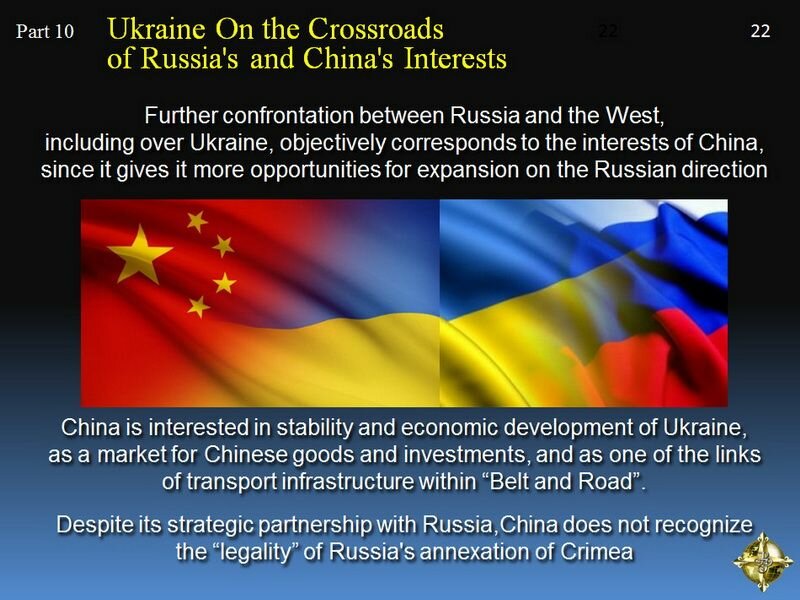
|
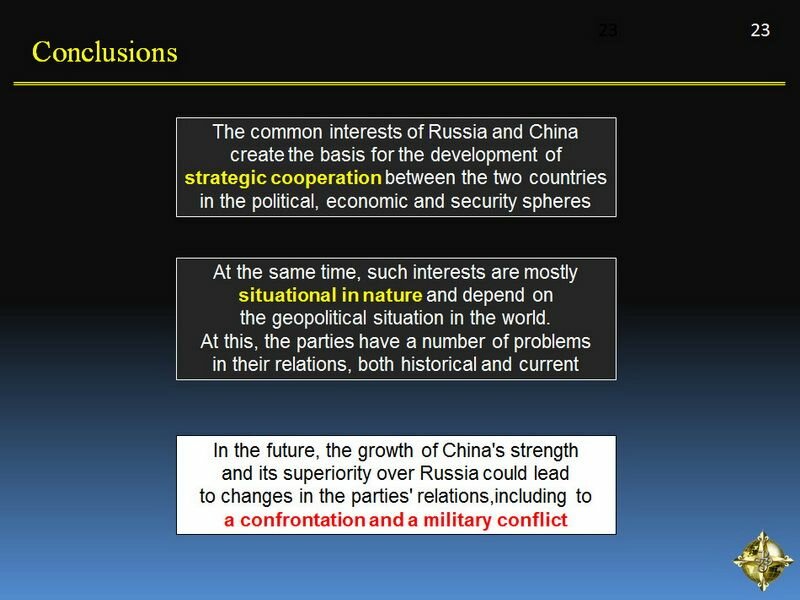
|
Conclusions
The common interests of Russia and China create the basis for the development of strategic cooperation between the two countries in the political, economic and security spheres.
At the same time, such interests are mostly situational in nature and depend on the geopolitical situation in the world. At this, the parties have a number of problems in their relations, both historical and current.
In the future, the growth of China's strength and its superiority over Russia could lead to changes in the parties' relations, including to a confrontation and a military conflict.

|

|

|
Photos by Volodymyr Rayevskyi

